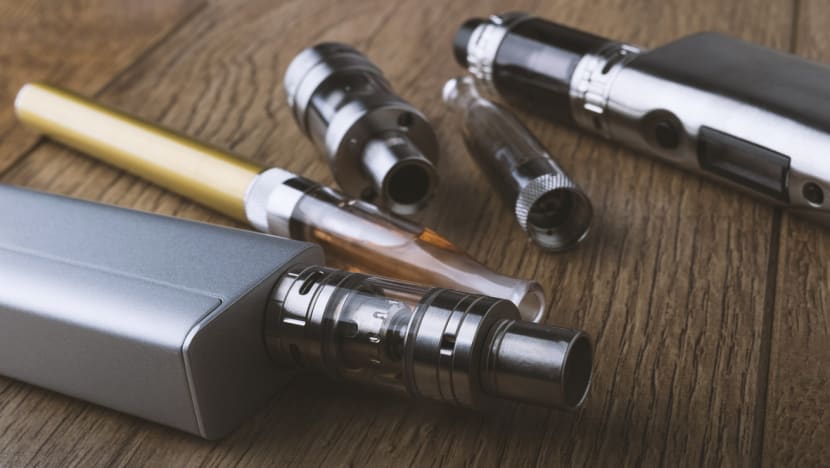Commentary: First it was cotton candy vapes. Now it’s cannabis and ketamine pods
If action is not taken now, the younger generation could be hooked on more than just nicotine, says Yvette van der Eijk of the Saw Swee Hock School of Public Health.

Vapes are being used to consume illegal drugs. (Photo: iStock)

This audio is generated by an AI tool.
SINGAPORE: A decade ago, as vaping surged in popularity, parents watched with growing alarm.
Sleek, discreet devices - many designed to resemble common school items such as pens and flash drives - lured young users with flavours such as “cotton candy” and “gummy bear”, making vaping both accessible and appealing. Today, parents have even more reason to worry.
With cannabis legalised in some countries, marijuana vaping has become more widespread among young people. In 2022, one in five United States students aged 16 to 18 reported vaping cannabis in the past year.
Meanwhile, growing reports of vapes being sold or spiked with illegal drugs such as opioids, ketamine and methamphetamine have raised fresh alarm, with cases of overdoses and even deaths among young people.
THE RISE OF DRUG-INFUSED VAPES
The vaping industry is now estimated to be worth US$22 billion, with around 80 million users worldwide.
One of the more recent and deeply concerning trends is the growing popularity of “Kpod” vapes. Kpods contain etomidate, a powerful anaesthetic similar to ketamine, in a mix also called “zombie spice” or “space oil”. It can cause seizures, coma and cardiac arrest.
Despite the risks, sellers market Kpods as “safe” and “undetectable in urine tests”, often in fruity flavours such as grape, blueberry and mango. They are virtually indistinguishable from regular vapes.
In the United Kingdom, a study last year found that one in six vapes confiscated at English schools was spiked with zombie spice. Teachers described how students had collapsed in hallways and ended up in intensive care after vaping this mix.
Though less common in Singapore, Kpods are being picked up by children as young as 12. Authorities have also seized vape devices containing THC, the main psychoactive compound in cannabis.
Concern over drug-infused vapes has intensified, with lawmakers in Singapore raising the issue several times in parliament this year.
In other countries, vapes have also been found to contain opioids like heroin and fentanyl, a particularly chilling development given that fentanyl can be up to 50 times more potent than heroin.
In February, Malaysian police busted a lab in Selangor producing meth-laced vapes, seizing RM10 million (US$2.26 million) worth of products intended for both domestic and international distribution.
GROWTH OF THE CANNABIS VAPING TREND
While drug-infused vapes pose immediate and unpredictable risks, cannabis vaping is also on the rise, under the misconception that it is harmless.
This is a dangerous assumption. Not only is cannabis addictive, but it can also cause memory loss, psychosis and respiratory issues.
Additionally, many cannabis vapes contain additives that pose severe health threats. One of the most notorious is vitamin E acetate, which has been implicated as the primary cause of EVALI (e-cigarette or vaping associated lung injury), a fatal condition that killed 68 people and hospitalised over 2,800 in the US between 2019 and 2020.
Despite these risks, the cannabis vaping trend is proving difficult to curb. The tobacco industry, which has aggressively invested in the vaping market, is now extending its reach into the cannabis market.
For example, in 2023, it was reported that Philip Morris International (PMI), was acquiring Israeli medical cannabis inhaler company Syqe Medical for US$650 million. In January this year, PMI also entered a partnership with Avicanna, a Canadian firm specialising in cannabinoid-based medicine.
Meanwhile, Marlboro-maker Altria Group is the largest shareholder of Canadian medical marijuana company Cronos Group, while British American Tobacco (BAT) has a major stake in Canada-based cannabis producer OrganiGram.
Many of these companies position themselves as specialists in cannabis therapeutics or research. But the tobacco industry’s track record for product safety raises serious doubts about its ability to develop safe cannabis vapes.
Cigarettes are the only legal consumer product that, when used exactly as intended by the manufacturer, kills about half of its users - a staggering figure considering there are an estimated 1.3 billion smokers globally.
MORE ACTION NEEDED
Even when vapes were limited to nicotine, they posed enough of a health threat, with studies linking them to lung injuries, heart disease and cancer.
Now, there is a new generation of illegal and dangerous drugs being sold to children under the guise of harmless fruit-flavoured vape pens and tech gadgets.
These drugs, as well as vaping products, are illegal in Singapore and their use comes with strict penalties. Countries such as China are also cracking down on drug-laced vapes amid their rising popularity in youths.
However, given the proliferation of online sales, stricter regulation of online platforms is essential to curb illicit sales across borders.
It is also important to educate young people on what is inside vaping products and on the dangers of using novel synthetic drugs such as etomidate. This is especially important as drug-infused vapes are difficult to distinguish from standard ones, and the ingredients in vape liquids are, more than often, neither disclosed nor labelled correctly.
Parents and teachers must also be equipped to recognise the signs of vaping and substance use, and at-risk youth should be given access to counselling and support services to prevent addiction before it takes hold.
If action is not taken now, the younger generation could be hooked on more than just nicotine.
Yvette van der Eijk is Assistant Professor at the Saw Swee Hock School of Public Health, National University of Singapore.




















